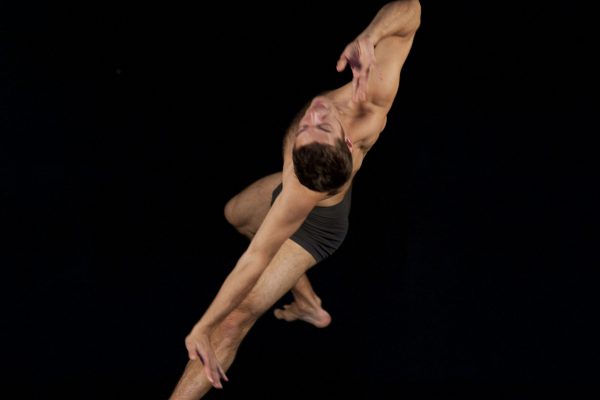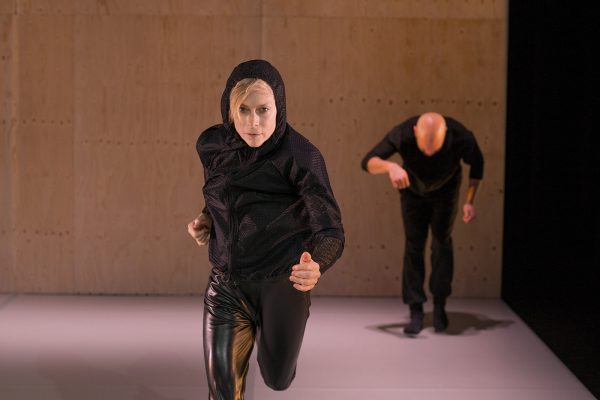It’s the morning after the closing of Snakeskins, a “fake solo” created by choreographer and dancer Benoît Lachambre, which played for two nights during Montréal’s Festival TransAmériques. Lachambre joined me at Place des Arts for a dialogue about the work and my impressions.
When we meet, I take a moment to admire the intensity of his brilliant blue eyes, his long ash-coloured hair and uneven gait. In them, I recognize aspects of the same person who astonished me onstage with both physical endurance and humility. Lachambre is stooped but resilient; a shape-shifter.
As we look for a place to have tea, Lachambre tells me about his background in somatics that began in the eighties with Amelia Itcush, whose Method brought principles from Alexander and Mitzvah techniques to dance. In Snakeskins, Lachambre suspends himself on a metal scaffolding from a leather harness around his neck. Sixty white ropes radiate toward the public from the structure. At its centre, Lachambre levitates through a reflexed rippling of his body. His capacity to tremble, shake and undulate through muscle, bone and organs is hallucinatory.
Snakeskins is full of symbols taken from aboriginal cultures. I had trouble deciphering Christine Rose Divito’s image, which was mounted as a large jigsaw puzzle set piece, so I ask Lachambre about it. “It is a vision of the ancestors and the contemporary situation,” he says: a dark pathway to knowledge, cleared and obscured throughout the performance.
When I ask Lachambre if the central set construction is meant to resemble the Plains aboriginals’ Sun Dances, his eyes light up. “This whole voyage is extremely pleasureful,” he says. “I’m sure that the Sun Dance must be that, times…?” and his eyes grow large imagining how it would be to overcome the pain of that rite of passage. He tells me his suspension in Snakeskins gives him incredible chills up his backbone as it frees the spinal fluid, completely free of discomfort.
As his green tea steeps, Lachambre’s expressions belie his view that the state of the world is what causes him to suffer, more than physical pain. Inequalities and environmental degradation are on his mind. In Snakeskins — through his embodiments of violence, schizoid mental states and defeats — Lachambre laments our inability to empathize, to care for one another and the earth.
“We’re all responsible for the situation we are in today,” he tells me, “and I’m very sad about it. I’m not excluding myself from it.”
Snakeskins has continued to be transformed since it’s creation in 2012, around the time of the end of the Mayan calendar with its ominous predictions. Lachambre tells me he was inspired by the “vision of a spiritual change” present at that time.
During Friday’s performance, in a crazed discussion with a basketball (a reference to an ancient Mayan ball game), Lachambre stated that in seventy-seven countries homosexuality is still illegal. The phrase seemed to sit apart from the rest of the piece, despite his deft ability to carry the text with a mix of humour and pathos. He explains that the section is different in each performance, as the numbers he riffs off come from the date of the performance. Aspects of his daily life, however, sometimes call for a softening of certain actions or more direct expressions of sorrow. “It’s the first time I go for something very political,” he confides. In his mind, the stated fact “is part of a whole system of values that needs to be changed. I’m in love at the moment! I want to get married …”
Be they oblique or overt, his belief is that the thoughts he brings to the stage carry a resonance into the world. “If you a send a thought, somewhere the thought passes. It makes its way,” he says.
Vibrations are present throughout Snakeskins. In an incredible moment of theatrical innovation, Lachambre manipulates the sixty ropes gathered at his waist, creating a morphing curtain of sine waves. The lighting designs of Yves Godin and the cinematic soundscape of processed violin and doom metal drones played by Lachambre’s longtime collaborator Hahn Rowe combine to produce a tremendous and breathtaking vision of flames, wings, tentacles or the disasters of cell division. It appears to me for a moment that he is engulfed in flames like Joan of Arc. I’ve never seen such basic materials produce such an impossibly magical effect in a theatre.
“The flame is a purifier, spiritually,” he says, but his position at the centre of this darting fire doesn’t intentionally refer to persecution.
The ropes inspire other images at different moments. Clambering on the structure wearing a luchador, or wrestling mask, Lachambre reminds me first of a bruised boxer thrown to the edges of a ring, then of a superhero in a spiderweb. Themes of power, and the relationships between defeat, vanquishing, and usurping, are strong. I ask him when he feels most powerful in the piece.
“A very, very simple and very pure flow of energy,” he says, “can feel more overwhelming than the most acrobatic action. When I toss myself in the ropes, it’s quite spectacular, but when I just open my head and I allow energy to get out from my chakras, my experience is perhaps a hundred times stronger.”
Through subtlety, Lachambre has an apparent ambition to merge theatre and life, to transgress barriers between spaces, people, dreams and puzzles. Treating time and space elastically in Snakeskins, Lachambre bows in and out of his roles, appearing and disappearing in an unending finale of tasks, improvised movements and reverences for anyone who remains after the applause. The space is stripped of its fantasies and everyone is revealed in changing light.
Lachambre’s generous offer to meet me on a busy day, when he is certainly exhausted from last night’s performance, is clearly a part of his process of seeing how we can continue to connect, once emerged from the cast-off skin of the performance. “It’s not only to make a good piece,” he says humbly. “It’s also to get in touch, so the process begins.”
Tagged: Choreography, Contemporary, Festival, Performance, Montréal , QC





